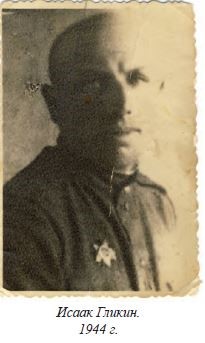Isaak Glikin was born in 1907 in Kiev. His father Zus (in Soviet documents the name appears as the Russian Zakhar) was a carpenter. His paternal uncle Iosif was a Communist Party functionary. From 1925 to 1928 Isaak served with the border forces of the Red Army in Mogilev-Podolskii (on the border with Romania). In 1931 he joined the Communist Communist Party and was recommended for political work in the army. From that time on his life was tied to the Red Army – the only break occurring in 1940 and 1941, when he was the director of a lumber mill in a suburb of Odessa. His family – his wife Klara and their children – followed him in all the places he served. Isaak was not religious; however, when they lived in Kiev, he did not prevent his father Zus from taking his son (Zus's grandson) to synagogue.
In 1939 and 1940, Isaak took part in the Soviet-Finnish (Winter) War. As a political worker with access to more information than the rank and file soldiers, Isaak was able to share with his family knowledge about the political situation in the world. He believed that war with Germany was inevitable and that it would be a catastrophe for the Jewish people.
With the beginning of the Soviet-German war, Isaak Glikin was again drafted into the Red Army. He wanted his wife to be evacuated, but Klara refused and instead went to live with her parents in Mogilev-Podolskii. As a result, she and their two children became prisoners in ghettos in Romanian-occupied Transnistria: first in Mogilev-Podolskii, then in nearby Kopaigorod. They survived the ghettos, but Klara's parents did not.
The first assignment of officer Isaak Glikin was the evacuation of state equipment eastward: he accompanied the evacuation train. In July he was assigned to active service as a political commissar. He was wounded during the Red Army's defense of Sevastopol and was awarded the For the Defense of Sevastopol medal. In 1942 he took part in the defense of the Caucasus and in the battle of Stalingrad (for which he received the Order of the Red Star), where he was wounded again. After his second injury, Glikin was sent to study at the Military Political Academy. After completing his course there, he was assigned to the 4th Ukrainian Front as the deputy commander for political matters (zampolit, in the Russian slang of those days) of the 665th Infantry Regiment) and took part in the liberation of Ukrainian cities, including Kiev. He was then awarded his second military order – that of the Patriotic War, 1st Class.
Major Isaak Glikin was killed in Latvia in August 1944. He was buried in a military grave in Dobele.
His son Mara and daughter Fira (Esther) live in Israel.







